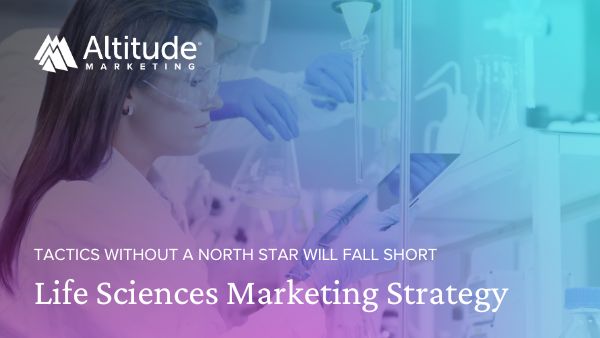In the ever-evolving life sciences industry, you need every advantage you can get to help your company stand out in the crowd. A key pillar to the success of any life sciences company is a clear, effective and actionable life sciences marketing strategy.
Where do you start with your life science marketing? In this blog, we will take a deep dive into life sciences marketing strategy – defining what it is and the steps you should follow to create an effective marketing strategy for your company.
To do that, we’ll cover the topics below:
- What is a life sciences marketing strategy?
- Why do life sciences companies need a clear marketing strategy?
- The 7 steps to create a life sciences marketing strategy
- Turning marketing strategy into marketing tactics

What is a life sciences marketing strategy?
Like any other B2B marketing strategy, a life sciences marketing strategy is a well-researched and targeted plan to promote and position your products or services in the marketplace.
It involves things like:
- Identifying and understanding the unique needs and challenges of your ideal customer profile (ICP) in the life sciences market
- Crafting compelling messaging that resonates with your ICP
- Deciding what marketing channel you will use to reach your ICP
Why do life sciences companies need an effective marketing strategy?
Marketing to life sciences companies presents a unique set of challenges.
The life sciences industry is high stakes. It’s comprised of many rapidly evolving niches, each creating its own unique products that directly impact the health and lives of many. All those niches require their own set of well-defined, well-researched messaging, talking to the highly sophisticated and usually marketing-averse scientists and researchers.
On top of those challenges, your target audience likely faces many regulatory hurdles that impact the ways in which they do business.
All these challenges must be clearly and concisely addressed in your marketing strategy. Without it, your messaging won’t resonate, your content won’t have value, and your campaigns won’t bring in leads.
7 Steps to Create a Life Sciences Marketing Strategy
#1: Define Clear Objectives
Effective life sciences marketing strategies are created with clear and definable goals.
First question: “What do you want to achieve as a result of your marketing strategy?”
Some examples of clear and definable goals include:
- Launching a unique product innovation
- Building awareness of scientific advancements
- Fostering trust and building relationships with key partners
- Driving brand awareness and end-user adoption of your solution
- Education and building demand for your product or service
- Generating qualified leads to fill your sales funnel
- Getting acquired by larger industry players
#2: Research
The best marketing strategies start with market research.
This is especially true in the life sciences space. There are many interconnected but distinct niches like pharmaceuticals, biotech, CROs, and more, all with unique challenges and competitive landscapes.
To begin creating an effective marketing strategy, you should conduct thorough market research to identify target audiences, understand the industry landscape, and assess competitors. This involves gathering information on scientific trends, customer needs, and potential opportunities and challenges in the specific niche within the life sciences sector you are targetting.
#3: Identify Your Target Audience
With research done, you should have the knowledge you need to identify your target audience.
In the life sciences field, this could include researchers, healthcare professionals, institutions, or industry partners. Find out what their challenges are and how your product and value proposition fit in. Create customer personas of each target audience you identify as an addressable market.
#4: Craft Compelling Messaging
With audiences identified, you can begin tailoring your specific messaging that will resonate with the specific needs and pain points of your audiences.
Always remain focused on the person and highlight the unique benefits of your products or services. Emphasize how your offerings address their specific challenges or contribute to their goals for scientific advancement. Connect your messaging to their desires, fears and aspirations.
Yes, a life sciences business will hopefully buy what you’re selling, but ultimately, you’re marketing and selling to people.
#5: Channel Selection
Now that you have clear and compelling messaging, it’s time to decide the best channels to distribute it.
To choose the most effective marketing channels to reach your target audience, you need to know where your audience is. Ask questions like:
- What trade publications do they read?
- What social media channels do they use?
- What websites do they go to?
- What tradeshows and conferences do they attend?
The goal here is to ensure your marketing materials follow the footsteps of your target audience.
#6: Measure and Analyze
To gauge the effectiveness of the resulting tactics that emerge from your strategy, you should have a plan in place to measure success.
That starts with identifying the key performance indicators (KPIs) to measure the success of your marketing efforts. These could include metrics like website visits, click-through-rate (CTR), conversion rate, leads generated, cost-per-lead (CPL), and lead-to-close ratio.
Your strategy should include plans to regularly assess the analytics to address what works well and where adjustments may be needed.
#7: Adapt and Evolve
A marketing strategy is a high-level, long-term plan. That doesn’t mean it’s something that should remain set in stone. An effective life sciences marketing strategy is a fluid and dynamic plan that can change as needed.
The life sciences landscape is dynamic. There are always ongoing advancements and changes. Your marketing strategy should always be reviewed and edited to account for those changes.
In addition to external market factors, you should always have a system in place to change the parts of your strategy that aren’t performing. Assessing your marketing strategy at least twice a year is good practice.
Part of an effective marketing strategy is knowing that sometimes messaging and campaigns will fall flat. Have processes in place for finding out why something didn’t work and pivoting where necessary.
Turning Marketing Strategy into Marketing Tactics
With your marketing strategy in place, you now know:
- Who you are targeting
- What you are saying to them
- The channels you will reach them
- How you will measure success
- How you will make changes in the future
This creates a roadmap for tactical marketing decisions, including deliverables like what blogs to write, what high-value content your audience will find compelling and the ad campaigns and email nurtures you should launch.
Conclusion: One Last Note on Marketing Strategy
Many people use the terms strategy and tactics interchangeably. When creating a marketing strategy, it’s common for those discussions to veer into tactical marketing discussions.
However, marketing tactics will fall short if they don’t have a clear North Star. Follow these steps to make sure you have that direction so all of your tactics work together to build a better whole.



